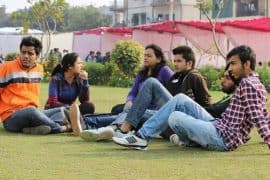DU has lived through multifarious eras. Hence, it’s only safe to assume that its heritage and
legacy, are something made for the books.
With all its troughs and crests, the University of Delhi (DU) has finally reached its centennial
year. This mammoth of a moment comes during an era of a cultural and political boom, and drawing a contrast between the nascent traditions and practices of the university and its contemporary versions comes as the only natural move to understand why DU is the way it is.
Charting the temporal political mapping of the university reveals a sort of political dilution that has come about over the years. There is an increase in university organisations endorsing the usage of top-down models to inculcate structural implementations that have evidently reduced the scope for diverse conversations.
There has been a depoliticization of campuses on purpose over the years because of the critical programmes that used to be conducted in our times, and that had to be reduced
because of the fervour they created.a professor of DU
When it comes to the academic shifts over the decades, one of the most critical changes being imbibed was the shift from an annual to a semester system. The latter became a part of the 2010-11 session. Until then, the academic system functioned on an annual basis. This
change was much debated at the time because of the questionable impact it sought to create.
In our times, we used to sit with a topic or reading and discuss it holistically. But now I feel students are made to skim through just to complete the syllabus in time. I mean, it is wrong,but it is also the way things are now.
a DU alumna
The semester system and the paucity of time to finish the syllabi prop up the question, “What is all this for?”
In our time, the syllabus used to be more academic,whereas now, it has become more industrially inclined to make students more skilled and employable for sure. But the important question is to find out the whereabouts of these internships.
Ms. Nancy Pathak, a Professor of Political Science at Lady Shri Ram College for Women, on the evolution of the syllabus and the culture of internships
The hustle culture and the dire need for an internship have steered the students into accepting whatever grunt work is thrown at them.
Lastly, mapping the “attendance” trajectory is yet another important facet of a DU student’s life.
I’ve noticed that attendance is such a strict criterion only in women’s colleges.
a professor at DU
The question here arises, what is the gendered rationale behind such strictness in attendance? Perhaps it is a question that creates a debate beyond the confinement of the article.
Regardless of all the good and bad, these comparisons have helped us trace the progressions and regressions over time, something which is true of every development, and that should be acknowledged to understand and respect the university’s run so far.
Read Also: Is DU Worth the Hype?
Featured Image Credits: Behind Cricket
Vidushi Sinha
Madiha Mattoo




Comments are closed.